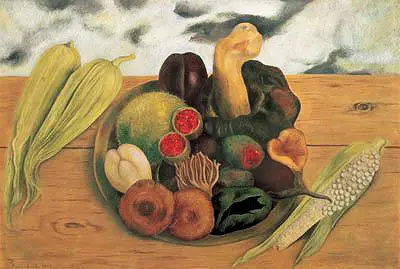Fruits of the Earth like many of her other major paintings employed the use of an oil medium and Masonite, which was a smooth hardboard discovered in the 1920s, as the media base. She used turpentine as her thinning and diluting material and preferred Mexican traditional oil paints from tubes. This painting, a still life painting by Frida Kahlo acknowledges the fertility of Mexico’s female earth. In the painting, fruits, corn, vegetables, mushrooms and flowers sit on a wooden table beside her. The artwork illustrates explicit, sexual portent as well as allusions to the sequence of life and death.
The painting highlights the struggles of being a woman in Mexican society. Fruits of the Earth reveals fruits resembling female sexuality and are therefore sexual representations. The background which is white and grey indicating a resilient view of nature and an impending storm characterised by a dark gloomy sky. Mercedes Zamora widely influenced and inspired Frida Kahlo’s Fruits of the Earth painting. Comparison between Mercedes Zamora's art work from 1896 and Frida’s Fruit of the earth painting reveals some similarity.
As a woman, Frida Kahlo's art vividly illustrated Mexican culture, politics, sexuality, fertility, marriage and the physical and emotional pain she experienced, with great sincerity. Most of her paintings, in this case Fruits of the Earth, were influenced by her Mexican culture which is illustrated by her use of bright colours and symbolism. Fruits of the Earth painting is an analogy for sexuality, pain and suffering that she experienced as a woman. Frida Kahlo's Fruits of the Earth painting is on display at The Kahlo Museum, which commemorates her life and artwork, located in La Casa Azul (The Blue House) in Mexico City. This was where she spent most of her childhood.

